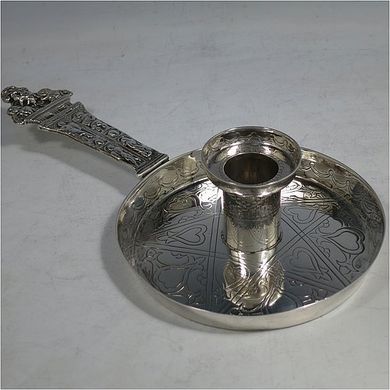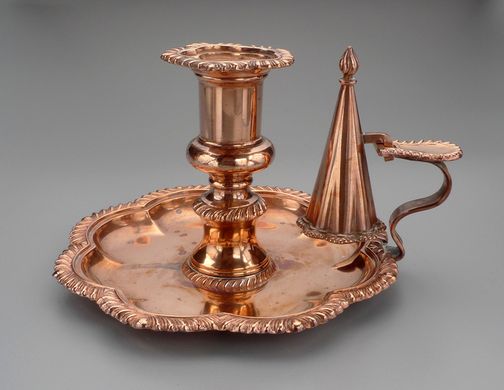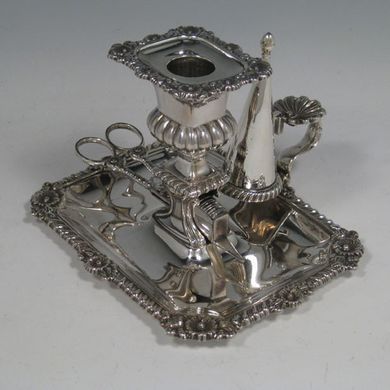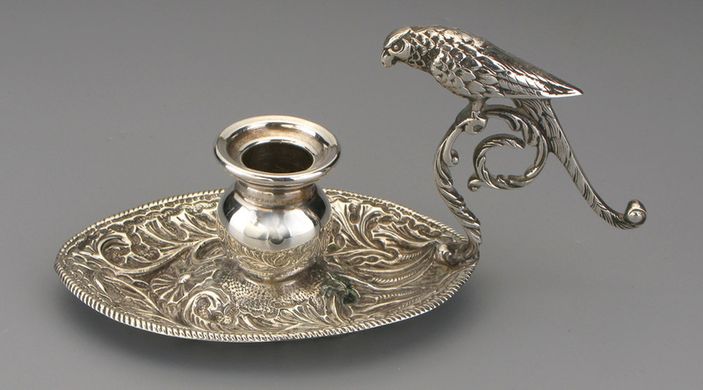 In our modern electric light world it is hard to imagine what it was like in the 1700's, but lighting was very well thought out. For example, candlesticks were placed in front of mirrors in order to increase the lighting effect given off by the candle flame. Even the metal candlesticks were polished in order to increase the reflection of the light.
In our modern electric light world it is hard to imagine what it was like in the 1700's, but lighting was very well thought out. For example, candlesticks were placed in front of mirrors in order to increase the lighting effect given off by the candle flame. Even the metal candlesticks were polished in order to increase the reflection of the light. Even the type of candle used was considered. Because beeswax candles burn around 3 times brighter than tallow candles they reflected more light in the mirrors. Tallow candles were therefore mainly used in chambersticks that were used to light the way to ones chamber. Chambersticks were very important as they lit the way in the dark when you needed to move from room to room. Once they had got you to your destination they were used to light the candlesticks in the room; the chamberstick was lit again before blowing out the main candlestick in the room so you could get safely to your bedside.
There are many types of candle holders from, candlesticks to candelabras, all of which were designed to be stationary. The chamberstick 
 however was designed to be carried from room to room. Because of their function, they are smaller in height, have a flat circular base to catch any dipping candle wax from falling onto the floor or onto clothing. They have a central socket to hold the candle, a sconce sometimes removable, and a carrying handle on the side and some also come with a snuffer. They can be made from silver, brass, pewter or porcelain.
however was designed to be carried from room to room. Because of their function, they are smaller in height, have a flat circular base to catch any dipping candle wax from falling onto the floor or onto clothing. They have a central socket to hold the candle, a sconce sometimes removable, and a carrying handle on the side and some also come with a snuffer. They can be made from silver, brass, pewter or porcelain.

 however was designed to be carried from room to room. Because of their function, they are smaller in height, have a flat circular base to catch any dipping candle wax from falling onto the floor or onto clothing. They have a central socket to hold the candle, a sconce sometimes removable, and a carrying handle on the side and some also come with a snuffer. They can be made from silver, brass, pewter or porcelain.
however was designed to be carried from room to room. Because of their function, they are smaller in height, have a flat circular base to catch any dipping candle wax from falling onto the floor or onto clothing. They have a central socket to hold the candle, a sconce sometimes removable, and a carrying handle on the side and some also come with a snuffer. They can be made from silver, brass, pewter or porcelain.Ironically a chamberstick would not be kept by your bedside. They would be kept on the entrance hall table as you came in the door so they could be used by various family members when they retired for the evening. The following morning they would be collected by a chamber maid and were then placed in one of two places depending on the wealth of the family. If the family was quite wealthy then they would have a candle room where everything was kept to clean the chambersticks ready for their use again that evening. Or they would be taken to an area of the kitchen where this function was performed. Wealthy 1700's households would have a candle man who would be employed full time to look after all the candleholders in the house.


Collector Notes
Chambersticks first made an appearance in the 1600's and early examples are now very hard to find. Originally they were made in sets as a household would need many chambersticks. They were used for lighting the way to bed or chamber and because of the movement created when they were carried about they needed a large drip pan to catch the wax. The earliest examples have straight handles, first flat and then tubular which were superseded in the first part of the 1700's by a ring handle. Gradually the design evolved and from the mid 1700's onwards and they usually had a matching conical snuffer although from about 1790 onwards some were made with an aperture at the base of the stem to take a pair of scissor snuffers.
